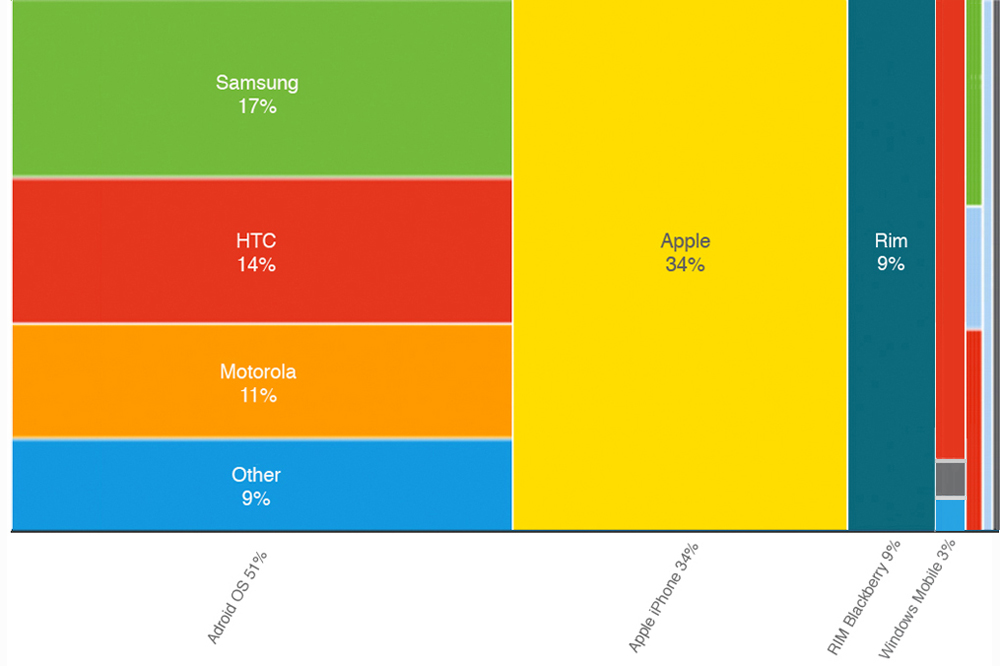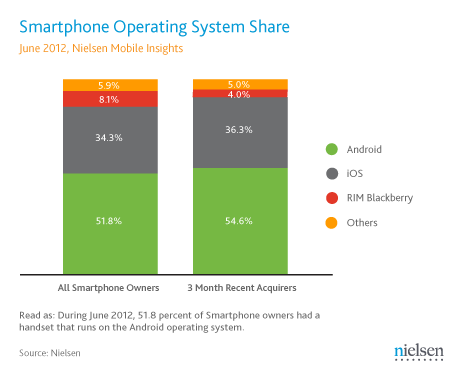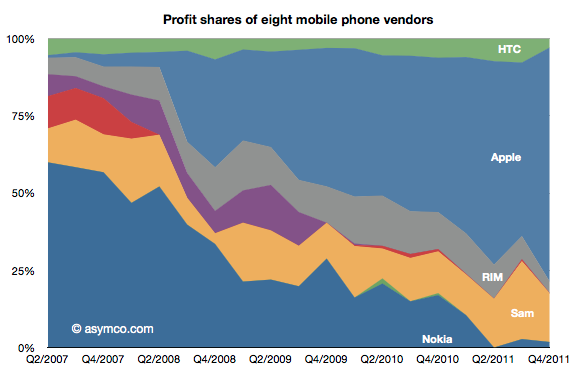
If you can look past the drama caused by the original version of this image released by Neilson (which made it appear as if Windows Mobile and RIM had a much higher US market share), you can see that there is a big battle raging between Apple and Android. With a combined 51% of the market you might think that Android is eating Apple’s lunch, but in reality, that’s not really the case. On a second look, Apple is actually the largest individual producer of phones with 34%. More importantly, what the above graph doesn’t show is that Apple makes nearly 75% of the profits in global mobile phone market and similarly in the tablet market. Their profits are visible in the graph below:
Apple has successfully proved their model of controlling all aspects of the device from start to finish. They not only reap the financial benefits of vertical integration in manufacturing, but they are also able to make sure the software works seamlessly with the hardware. It looks like the other players in the game have decided to emulate Apple’s strategy.
With the recent announcements of the Microsoft Surface and the Google Nexus 7 tablet, both companies are showing their new vertical strategies. Google chose not to go all the way vertical, but to work closely with the hardware manufacturer Asus, even though they own Motorola. This is because they do not want to scare off their Android Partners. Google makes it’s money not from the devices themselves, but from the search ads on Google-integrated Android devices and from purchases in the Play store. Therefore it is in Google’s best interest that Android spreads as fast and as far as possible. So right now Google’s partners need not worry as much, because Google is mostly using Motorola for it’s patents, but as it becomes more and more of a hardware manufacturer (think Google Glasses and the Nexus Q), it will probably start to manufacture it’s flagship products.
Microsoft made a bold move to cut out the middle-man and build the Surface themselves. Whereas Google gives their operating system away for free and makes money on the backend, Microsoft makes their money upfront by charging license fees for each device a manufacturer builds . The license fee for a Windows 8 Surface is somewhere around $50-$65. So not only does Microsoft have a great advantage in integrated design over their OEM producers, but because they do not have to pay a license fee, none of the OEMs will be able to match their price. Microsoft is basically screwing over all their manufacturing partners to compete with Google and Apple head-on. Many people think this is just to get Windows 8 tablet market share, and that they will eventually step back and just take their fees. I don’t know if I buy this theory, but I guess they really had no other choice. All of this should tell you how important and competitive the tablet market is going to be in the coming years for the Tech Titans.

The other front of the battle between the Tech Titans is the smartphone market and the trend towards vertical integration directly effects the smartphone market. The more vertically integrated forms of these companies will likely lead to higher and higher quality smartphones as the economics of scale and more powerful technology of tablets, trickles down. The technology in smartphones has already gotten cheap and powerful enough that there is really no longer such thing as a dumb phone. The graph above illustrates that 2 out of 3 phones purchased in the last three months was a smart phone and not a feature phone.
This is the lowest percentage of smart phones there will ever be, as there will pretty much only be smartphones from here on out. The only things holding the total proliferation of smartphones back, are the increased costs of data plans and the small percentage of late adopters out there. It is now possible to get an Android phone with unlimited voice, data and messaging for less than $50 a month, so it is really only a matter of time until the market catches up.
Smartphones and tablets are definitely the next era of technology for the future. The question is, which company’s strategy is going to win?

